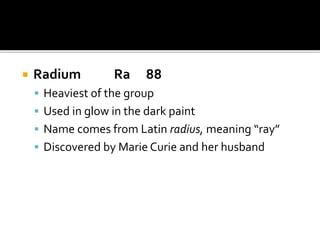This document summarizes the properties and uses of the elements in the periodic table. It describes the alkali metals like lithium, sodium, and potassium as soft, silvery solids that are very reactive and discusses their common uses in batteries, medicine, construction materials and more. It also outlines groups like the alkaline earth metals, boron family, carbon group, nitrogen group, oxygen family, halogens, and noble gases, noting characteristics and applications of elements in each group.







































